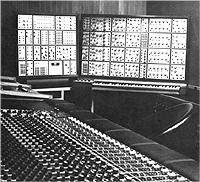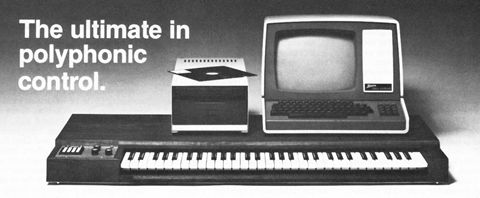Modular
Eµ Modular Overview

Modular During late 1972 Dave and Scott worked on building a set of analog synthesizer circuits and a monophonic keyboard for a new totally modular synthesizer. In early 1973 they launched the new Modular synthesizer as a completed product and as a set of kits.
Over the next year the number of high quality, professional modules expanded. The panels were built of heavy duty aluminum, with cemet pots and full sized 1/4" jack connectors. Prospective owners could specify which module and cabinets they wanted, as well as choosing from either a monophonic or polyphonic keyboard. Customers could also buy sub-modules, which were the core elements of each module, to build up into finished modules.
Documentation Dave and Scott produced their first official catalog in early 1974 with a detailed listing of every module and sub-module available. They also produced a short form catalog in the same year, and a price list. During the next 2 years they issued regular minor updates to the manual every 6 months or so, and price lists were also updated - although the prices didn't really change much. The Technical Catalog was re-issued in 1978 with the revised SSM based modules, and then a final version was issued in September 1980 complete with details of the Audity System.
Users The Eµ Modular was initially aimed at experimenters and hobbyists, but universities and high profile studios around the US became the key customer base. Several well known 1970's US based musicians bought examples, and Patrick Gleeson in San Francisco created one of the largest configurations and recorded a number of albums based on the Eµ Modular. More recent users include Vince Clarke.
Low Profile Dave and Scott kept their company at a low profile for the first few years. "We are basically opposed to conventional advertising, and prefer to rely on word of mouth". They did build up a dealer network in the US, as well as selling directly from the factory. Dealers were expected to have a demonstration modular in a studio environment. They exhibited at AES for the first time in 1975.
Models The Eµ Modular synthesizers were built to order, so each one of the approximately 100 - 150 made are all different. They were manufactured from 1973 - 1981.
Design "The goal of our circuit design is to get the ultimate in performance, compatibility with competitive professional pricing. Of particular significance are the criteria of wide dynamic range, low distortion and noise, flexibility and reliability. The modular system was conceived as an optimum general purpose studio unit, also usable in sophisticated live performance". From the Eµ Systems Technical Catalog 1974
ValuesToday Eµ Modulars range in value depending on the configuration and condition, but a typical price is $/£8 -10,000.
Why Eµ? Dave named the company after the initial letters of Electronic Music, and then choose Greek for the Mu. "Our business is and will continue to be a modest venture; quality electronic music systems are not a volume product and cannot alone support a large corporation. We prefer to think of ourselves as craftsmen rather than manufacturer, as each system we build gets a good deal of special attention".
Dave and Scott dropped the Greek alphabet around 1980, after becoming an incorporated company called E-mu Systems Inc. Greek was not allowed in a USA company name!
Other Developments Whilst continuing to manufacture the modular range, Eµ Systems also worked on a number of other interesting developments. They developed a 16 voice polyphonic digital scanning keyboard in 1976 using a Z80 microprocessor (after building a monophonic one in 1973 using TTL logic). This became the basis for the Sequential Circuits Prophet 5 (and provided excellent license revenues!) and various Oberheim's.
They also worked on an abortive Guitar synthesiser for Dave McLaughlin, and they collaborated with Solid State Music to create the famous range of SSM analog synthesiser chips (used in several famous synthesizers and some Emulator's).
4070 Floppy Disc System
Overview The 4070 was a luxury addition to the 4060 keyboard, launched in the fall of 1980 at the same time as the Synclavier II digital synthesizer and revised dual manual Prophet 10. If you had expanded the sequencer memory with at least one 4065 option of 16 Kbytes of RAM, you could use the 4070 for the quick storage and recall of polyphonic sequences and programs from the 4060 keyboard. The unit consists of an 8" floppy drive in a white cabinet, with a power supply and interface electronics to the 4060. A ribbon cable attached the keyboard to the disk unit. Each floppy diskette could store six full sequencer memories for a total capacity of 36.000 notes. A CRT interface was also launched with an integral keyboard, for use with the new programs. The 4070 shipped with a new ROM for the 4060 as well as UP1.1 and ten blank diskettes. It cost $3000.

4070 Advert Text Since Eµ Systems introduced the 4060 microprocessor-based 16 channel keyboard/sequencer in 1977, it has represented the state of the art in sophisticated synthesizer controllers. It has been the overwhelming choice of recording studios, universities , and such musicians as Herbie Hancock, Daryl Dragon, Pat Gleeson, and Frank Zappa. Today it stands at the center of the most powerful system of electronic music hardware and software available to the serious synthesist.
The basic keyboard will control 16 independent synthesizer channels with programmable control of keyboard split, glide, transposition, and channel assignment mode. The built-in 16 channel digital memorysequencer allows the creation of multi-channel compositions of up to 6,000 notes in real time - without the need for a multi-track tape recorder. The integral tape interface allows the storage of sequences in digital form on standard audio tape.
Programs from our special function software library add such capabilities as editing and merging polyphonic sequences, redefinition of keyboard tuning, non-realtime sequence generation, and interfacing to video synthesizers.
Our new 4070 floppy disc system allows fast, convenient storage and recall of sequences and special function software. Each 8" disc will hold six full sequencer memories, for a total capacity of 36,000 notes. Also included is a CRT terminal interface for use with forthcoming software.
For more information about the 4060 keyboard, the Eµ modular synthesizer, and the incredible new AUDITY 16 channel digitally controlled polyphonic synthesizer system, send $10.00 for the 150 page Eµ Systems Technical Catalog, with photos, specifications, and functional descriptions of all Eµ products. (Calif. residents be sure to add sales tax.)
Basic Modules
- 2000 - VCA
- 2010 - Quad VCA
- 2100 - VCF LPF
- 2110 - VCF - HPF
- 2120 - UAF
- 2140 - Resonant Filter
- 2145 - Filter Controller
- 2200 - VCO
- 2210 - Saw/Pulse VCO
- 2310 - Early TG (1973)
- 2320 - Early TG (1973)
- 2340 - VC Lag
- 2350 - Dual TG
- 2355 - VC TG
- 2400 - Noise Source
- 2410 - Sample & Hold
- 2420 - Dual Preamp
- 2430 - Ring Modulator
- 2440 - Env Follower
- 2450 - Quad Invereter
- 2451 - Potporri
- 2455 - Mixer
- 2460 - Dual Reverb
Other Components
Sequencer Modules
- 2500 - VC Clock
- 2510 - Address Generator
- 2520 - Voltage Source
- 2530 - Analog Switch
- 2540 - Memory Address
- 2545 - Memory
- 2546 - Programmer
- 2547 - Tape Interface
- 2550 - Hex Inverter
- 2551 - Triple OR
- 2552 - Triple Latch
- 2553 - Dual One Shot
- 4000 - Monophonic
- 4050 - Polyphonic
- 4060 - Keyboard/Sequencer
- 4070 - Disk Subsystem
Keyboards
Prices
- New Prices 1973 - 1981: $3-10,000
- Secondhand Prices (Very hard to locate): $5-10,000